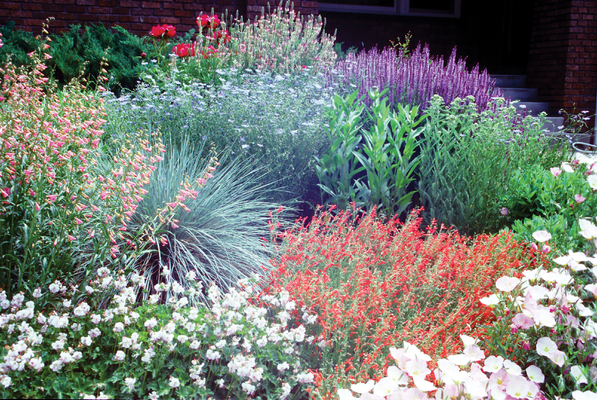
by Lisa Song Thursday, January 5, 2012

Minimum-water landscaping, or xeriscaping, doesn't necessarily mean planting just cacti. Denver Water
“The word ‘xeriscape’ brings to mind a lot of pebbles with cacti,” says Janet Ward, public relations manager for the City of Atlanta’s Department of Watershed Management. “That’s not what xeriscaping is, but that’s what people think it is.” Xeriscaping is simply minimum-water landscaping. It can involve everything from stones and cacti, to sedums, drought-tolerant plants and native bushes. Indeed, a glimpse into yards in Denver, Colo., often reveals fiery blanketflowers, magenta poppy mallows and sky-blue forget-me-nots.
But despite needing to conserve water, “xeriscaping [on a large scale] is not gonna happen [in Georgia],” says Sally Bethea, executive director of Upper Chattahoochee Riverkeeper in Atlanta, a nonprofit that works to protect the river. “The green industry is incredibly strong.” Before the last drought began, the green industry contributed some $8 billion to Georgia’s economy. During the drought, landscaping interests threw their support behind Georgia House Bill 1281, a state law prohibiting local governments from imposing outdoor watering rules different from those of the state.
For Sherry Loudermilk, executive director of Georgia Green Industry Association, 1281 was a matter of practicality. Counties and cities were changing their watering restrictions so quickly that landscapers couldn’t keep track of what was legal.
Local governments can get around 1281 by writing to Georgia’s Environmental Protection Division. Dozens of petitions have already been approved, but only for those requesting less stringent watering restrictions. “The state has made it virtually impossible for local governments to prove their need for more stringent outdoor watering requirements,” Bethea says. Applicants have to prove that tighter restrictions are necessary to maintain local public health and fire safety. Although Atlanta started the paperwork, the city was unable to meet the petition requirements.
In the end, although it may save a lot of water in arid environments like Denver and Albuquerque, N.M., some forms of xeriscaping may not be practical in Georgia’s wet climate, where the lack of vegetation could cause excessive runoff or erosion. Atlanta promotes a different style of xeriscaping: Instead of ripping out grass, residents are encouraged to use native drought-tolerant plants that save water while preventing erosion.
© 2008-2021. All rights reserved. Any copying, redistribution or retransmission of any of the contents of this service without the expressed written permission of the American Geosciences Institute is expressly prohibited. Click here for all copyright requests.